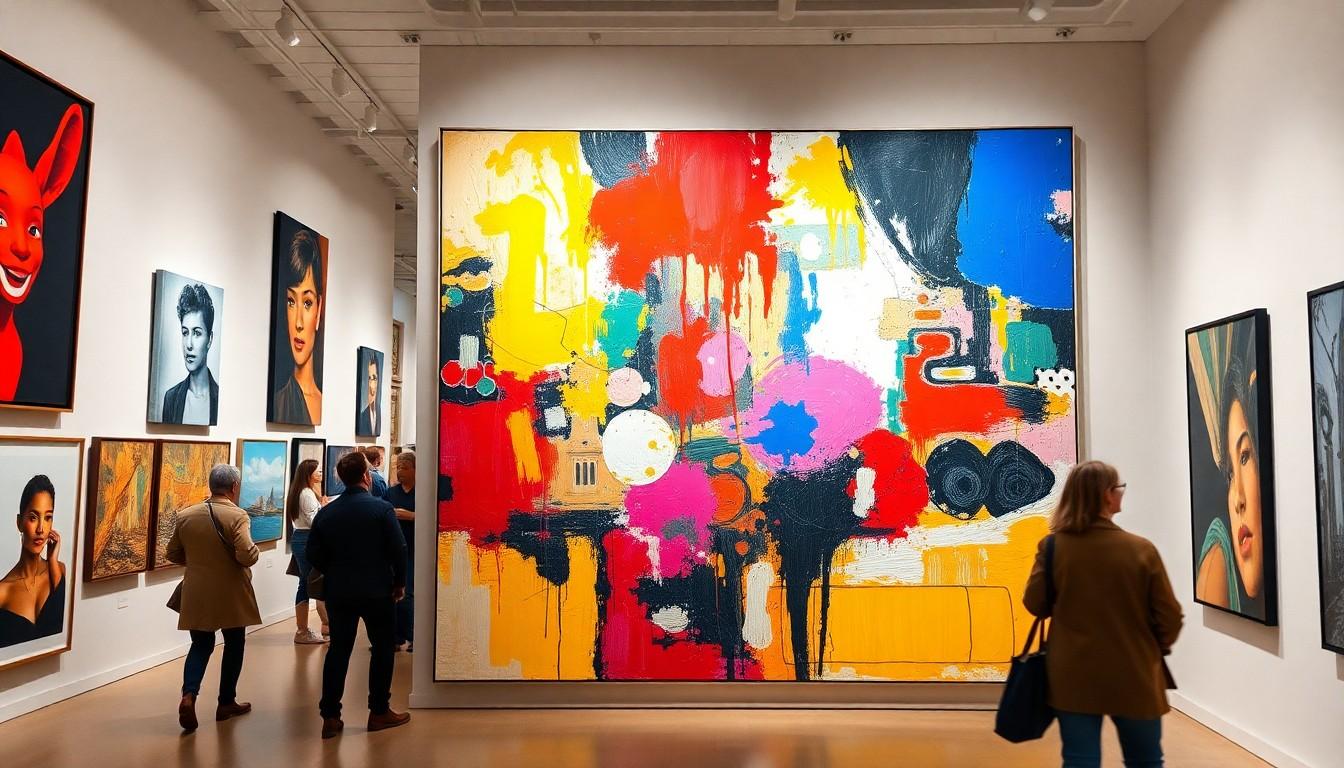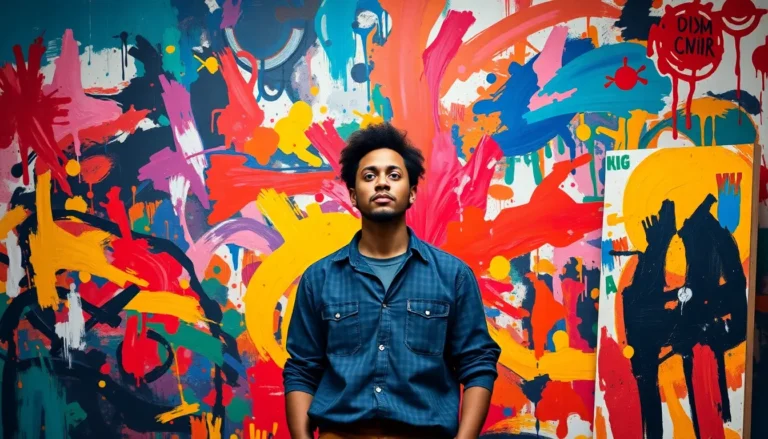When it comes to modern art, America and Europe are like two artists at a party—both talented but with wildly different styles. While European artists often embraced tradition and refined techniques, American creators threw caution to the wind, mixing bold experimentation with a dash of irreverence. Picture a European gallery filled with serene landscapes and classical portraits, while across the ocean, an American artist splashes vibrant colors on a canvas, channeling the chaos of urban life.
Table of Contents
ToggleOverview of Modern Art
Modern art in America showcases a distinctive approach compared to European counterparts. While European artists often emphasize tradition, American artists focus on innovation and the exploration of new ideas. European works typically feature refined techniques, serene landscapes, and classical portraits, offering a sense of nostalgia and familiarity.
Conversely, American modern art embraces bold experimentation and raw emotion. Artists such as Jackson Pollock and Mark Rothko reflect chaos and vibrancy through their use of color and form. These artists capture the urban experience, conveying energy and movement unique to American life.
Abstract Expressionism emerged prominently in America, fostering a movement characterized by spontaneity and personal expression. Many artists within this movement reject established norms, choosing instead to create works that resonate with individual feelings and experiences. The influence of jazz and popular culture further propels American art away from European traditions.
A variety of other movements also flourished within the American landscape. Pop art, led by figures like Andy Warhol, transforms commercial elements into fine art, emphasizing consumerism and mass production. This movement contrasts sharply with the introspective nature of many European works.
American modern art thrives on its daring spirit and cultural diversity. Urban life, societal change, and the infusion of various cultural influences shape artistic expression. Each piece captures the American ethos in its unique way, differentiating it significantly from European styles.
Historical Context

Modern art evolved uniquely in Europe and America, each influenced by its historical background and cultural dynamics.
Development in Europe
European modern art emerged from a rich history of tradition and academic training. Artists like Pablo Picasso and Henri Matisse embraced revolutionary techniques, breaking away from classical forms. The impact of World War I shifted artistic focus, leading to movements such as Dada and Surrealism that questioned reality and societal norms. Many artists responded to the chaos of their time by exploring abstraction and existential themes. This period showcased a blend of avant-garde movements, fostering dialogue about art’s role in society. Many European artists remained rooted in historical context while pushing boundaries, striving for aesthetic beauty and intellectual engagement.
Development in America
America’s journey into modern art unfolded within a context of rapid change and cultural diversity. Innovators like Jackson Pollock and Willem de Kooning pioneered Abstract Expressionism, emphasizing spontaneity and emotional resonance. Cities became vibrant hubs for artistic experimentation, drawing influence from jazz and street culture. Artists often challenged traditional norms, celebrating individuality and the chaotic nature of urban life. The rise of Pop Art, led by Andy Warhol and Roy Lichtenstein, further showcased the intersection of art and consumerism. This movement embraced commercial elements, recontextualizing everyday objects into high art. American modern art thrived on the spirit of freedom, redefining artistic expression amidst a backdrop of societal change.
Key Differences in Style
Modern art in America significantly diverges from its European counterpart, reflecting distinct cultural narratives and artistic priorities.
Abstract Expressionism vs. European Movements
Abstract Expressionism represents a major American innovation, emphasizing spontaneous and emotional expression. This movement contrasts with European art, which often leans toward structured movements like Surrealism and Dada. In Europe, artists like Salvador Dalí and Max Ernst explored subconscious themes, responding to societal upheaval with intricate symbolism. American artists, however, focus on raw emotion and individuality, often rejecting pre-established artistic conventions. While European art frequently seeks intellectual engagement, American movements prioritize personal experience and improvisation, creating a unique dialogue between artist and viewer.
Use of Color and Form
Color and form play crucial roles in distinguishing American modern art from European styles. American artists, such as Mark Rothko and Jackson Pollock, utilize bold colors to evoke intense emotional responses. The use of vibrant hues and dynamic forms often captures the energy and chaos of urban life. Conversely, European artists typically employ a more muted palette, reflecting their historical roots and a longing for tradition. In European modern works, color serves as a means to achieve harmony and balance. Thus, the choice of color and form underscores the divergent artistic philosophies inherent in each region’s modern art landscape.
Influential Artists
Modern art’s evolution in America and Europe reflects each region’s unique cultural narratives. Significant artists have shaped their respective movements and left lasting impressions on the art world.
American Artists and Their Contributions
Jackson Pollock revolutionized modern art with his drip technique, embodying spontaneity and chaos. Mark Rothko embraced color fields to evoke deep emotional responses. Willem de Kooning blurred the lines between abstraction and representation, demonstrating a fluid approach to painting. Andy Warhol challenged perceptions of art through pop culture icons, merging consumerism with artistic expression. These innovators defined American modern art, showcasing bold experimentation and a focus on individual identity.
European Artists and Their Impact
Pablo Picasso’s cubism broke traditional boundaries and redefined visual language in art. Henri Matisse’s vibrant colors and innovative forms emphasized personal expression and emotional depth. Salvador Dalí’s surrealist imagery explored the unconscious mind, pushing societal norms and expectations. Artists like these drew inspiration from historical contexts while challenging conventions. Their work reflects a rich lineage of artistic inquiry that influenced future generations across Europe and beyond.
Cultural Influences
Cultural influences significantly shape modern art’s evolution in both America and Europe. Each region’s historical backdrop plays a crucial role in defining artistic methodologies.
American Identity and Modern Art
American modern art resonates with the spirit of innovation, reflecting the nation’s diverse cultural landscape. Artists like Jackson Pollock and Andy Warhol embody this ethos, capturing the chaotic energy of urban life through their works. Unique artistic expressions reflect experiences shaped by the hustle and bustle of American society. The influence of jazz and popular culture further enhances this dynamic, introducing new forms and unexpected themes. Movements such as Abstract Expressionism prioritize individuality and spontaneity, allowing artists to translate personal emotions onto canvases. This focus moves away from traditional techniques, establishing a bold identity that characterizes American art in the modern era.
European Traditions and Innovations
In Europe, modern art emerges from a rich history laden with tradition and classical training. Influential figures like Pablo Picasso and Henri Matisse challenge conventional forms while remaining anchored to their cultural roots. Artistic responses to significant events, such as World War I, highlight the period’s turmoil and shifting perspectives. Dada and Surrealism represent radical departures from established norms, setting the stage for innovative explorations of reality and the subconscious. Structural themes and intricate symbolism often prevail in European works, contrasting with the emotional resonance featured in American art. The interplay of historical context and innovation illustrates the unique trajectory of European modern art.
The differences between modern art in America and Europe highlight the rich tapestry of cultural influences that shape artistic expression. American art thrives on innovation and emotional resonance, while European art often reflects a deep-rooted tradition and intellectual engagement. This divergence not only showcases distinct artistic priorities but also emphasizes the unique narratives that each region conveys through their work.
As artists continue to evolve and explore new ideas, the contrast between these two realms of modern art will remain a testament to their respective histories and cultural identities. The vibrant energy of American modern art stands in stark relief against the structured elegance of European styles, creating a dynamic dialogue that enriches the global art landscape.



